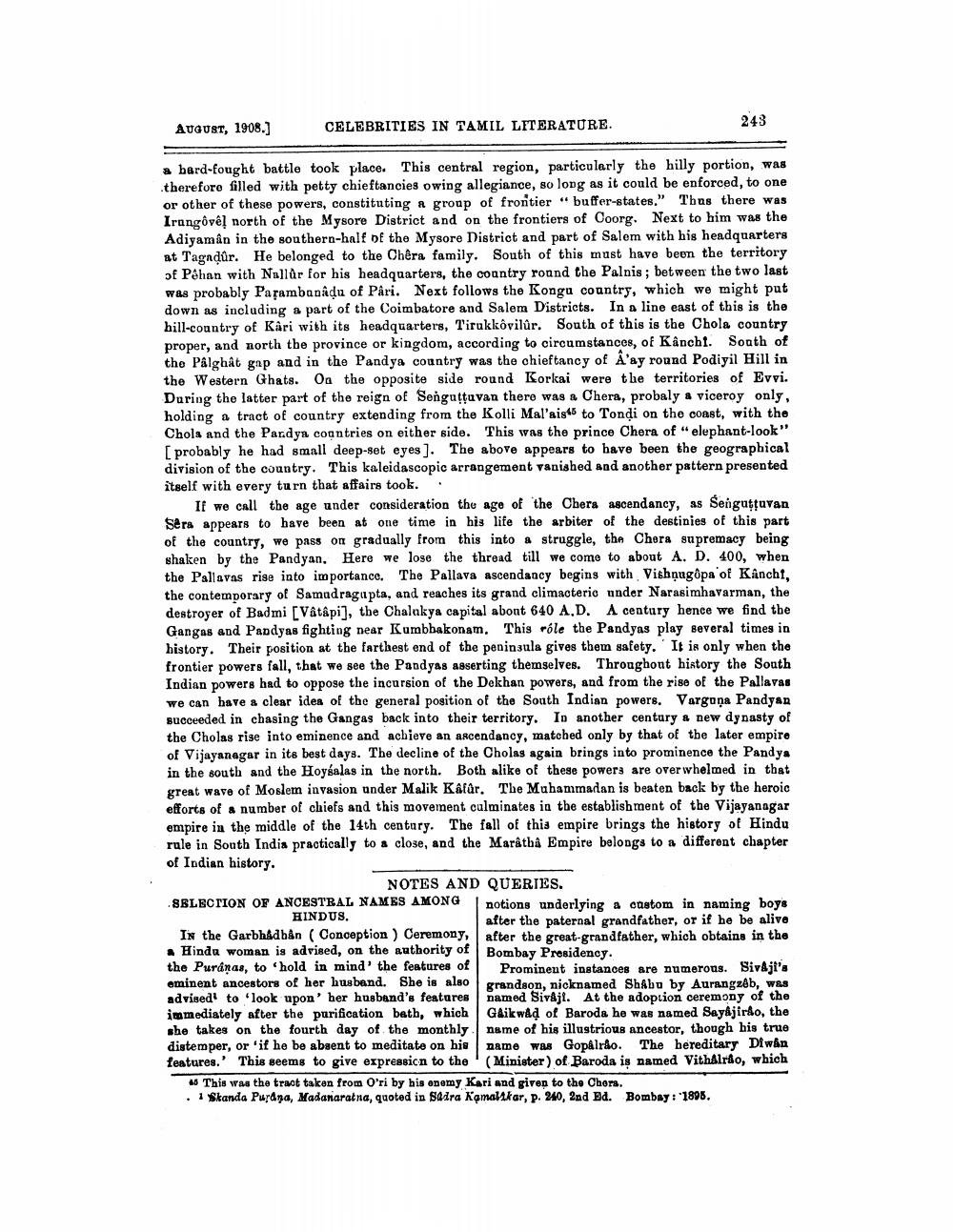________________
August, 1908.)
CELEBRITIES IN TAMIL LITERATURE.
a bard-fought battle took place. This central region, particularly the hilly portion, was therefore filled with petty chieftancies owing allegiance, so long as it could be enforced, to one or other of these powers, constituting a group of frontier " buffer-states." Thus there was Irangôvê! north of the Mysore District and on the frontiers of Coorg. Next to him was the Adiyaman in the southern-half of the Mysore District and part of Salem with his headquarters at Tagndür. He belonged to the Chêra family. South of this must have been the territory of Pehan with Nallûr for his headquarters, the country round the Palnis ; between the two last was probably Parambanadu of Påri. Next follows the Kongu country, which we might put down as including a part of the Coimbatore and Salem Districts. In a line east of this is the hill-country of Kari with its headquarters, Tirukkóvilûr. South of this is the Chola country proper, and north the province or kingdom, according to circumstances, of Kancht. Sonth of the Palghat gap and in the Pandya country was the chieftancy of Alay round Podiyil Hill in the Western Ghats. On the opposite side round Korkai were the territories of Evvi. During the latter part of the reign of Sengattuvan there was a Chera, probaly a viceroy only, holding a tract of country extending from the Kolli Mal'aist to Tondi on the coast, with the Chola and the Pandya countries on either side. This was the prince Chera of elephant-look" (probably he had small deep-set eyes]. The above appears to have been the geographical division of the country. This kaleidascopic arrangement vanished and another pattern presented itself with every turn that affairs took. .
If we call the age under consideration the age of the Obera ascendancy, as Sengustuvan Sera appears to have been at one time in his life the arbiter of the destinies of this part of the country, we pass on gradually from this into a struggle, the Chora supremacy being shaken by the Pandyan. Here we lose the thread till we come to about A. D. 400, when the Pallavas rise into importance. The Pallava ascendancy begins with Vishnugopa of Kancht, the contemporary of Samudragupta, and reaches its grand climacteric under Narasimhavarman, the destroyer of Badmi (Vatâpi], the Chalakya capital about 640 A.D. A century hence we find the Gangas and Pandyas fighting near Kumbbakonam. This role the Pandyas play several times in history. Their position at the farthest end of the peninsula gives them safety. It is only when the frontier powers fall, that we see the Pandyas asserting themselves. Throughout history the South Indian powers had to oppose the incursion of the Dekhan powers, and from the rise of the Pallavas we can have a clear idea of the general position of the South Indian powers. Vargoņa Pandyan Bucceeded in chasing the Gangas back into their territory. In another century & new dynasty of the Cholas rise into eminence and achieve an arcendancy, matched only by that of the later empire of Vijayanagar in its best days. The decline of the Cholas again brings into prominence the Pandys in the south and the Hoysalas in the north. Both alike of these powers are overwhelmed in that great wave of Moslem invasion under Malik Kâfâr. The Muhammadan is beaten back by the heroic efforts of a number of chiefs and this movement culminates in the establishment of the Vijayanagar empire in the middle of the 14th century. The fall of this empire brings the history of Hindu rule in South India practically to a close, and the Marath Empire belongs to a different chapter of Indian history,
NOTES AND QUERIES. SELECTION OF ANCESTRAL NAMES AMONG notions underlying a custom in naming boys HINDUS.
after the paternal grandfather, or if he be alive In the Garbhadhán (Conception ) Ceremony, after the great-grandfather, which obtains in the
Hindu woman is advised, on the authority of Bombay Presidency. the Puranas, to hold in mind the features of Prominent instances are numerous. Sivaji's eminent ancestors of her husband. She is also grandson, nicknamed Shabu by Aurangzób, was advised to look upon her husband's features named Sivajt. At the adoption ceremony of the immediately after the purification bath, which Gaikwad of Baroda he was named Sayajirao, the she takes on the fourth day of the monthly name of his illustrious ancestor, though his true distemper, or 'if he be absent to meditato on his name was Gopalrao. The hereditary Diwan features. This seems to give expression to the Minister) of Baroda is named Vithalrdo, which
10 This was the tract taken from O'ri by his enemy Kari and given to the Chora. . 1 Skanda Purana, Madanaratna, quoted in Badra Kamalikar, p. 240, 2nd Ed. Bombay: "1898.




